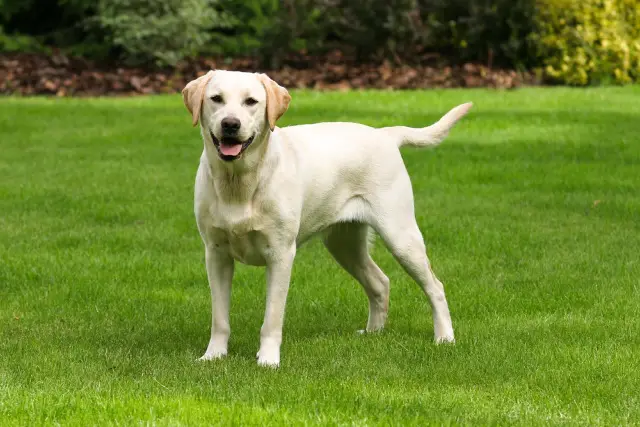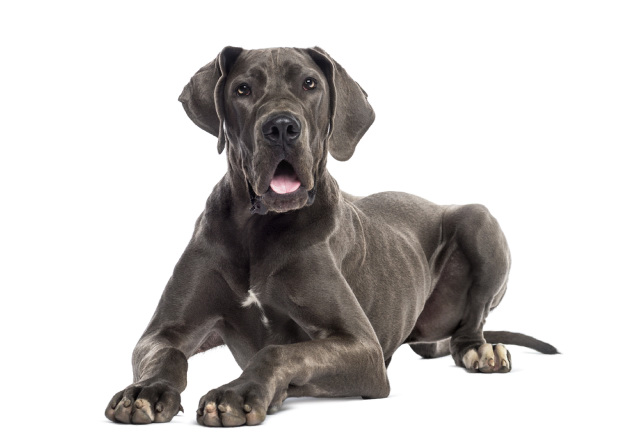Deep chested, barrel-chested – does chest shape and size really make a difference? You may be surprised to discover that breeds with similar chest types often have common traits, builds, and medical susceptibilities.
Let me try to break down some chest-type similarities and differences for you, as well as some pros and cons you should be aware of.
Knowing a dog’s weaknesses and strengths will ensure you choose the breed that best suits your lifestyle and budget.

Related: Barrel Chested Dog Breeds Explained | 16 Deep Chested Dog Breeds & Health Risks
Barrel Vs. Deep-Chested Dogs (Examples Included)
Knowing and recognizing what barrel and deep-chested dogs are, is the first step to understanding your dog’s personality, health, and abilities.
What Is A Barrel-Chested Dog?
Many dog breeds are naturally barrel-chested such as the Pug, Boxer, and Terrier (to name a few). Yet, oodles of mixed-breed dogs also end up with barrel chests due to their assortment of genes.
There are dog breeds that, via breeding, develop barrel chests, although they are not naturally intended to. An example of one of these breeds would be the Labrador Retriever.
Barrel-chested dog’s chests are (surprise, surprise) in the shape of a barrel. These dogs have deep, wide, rounded rib cages and wide, rounded shoulders. The bottom of their chest ends above or in line with their front elbows.
Barrel-chested dogs are typically strong, solid, and muscular, and your medium to large breeds are often bred for hunting and guarding. Not only are they known to be highly loyal and protective, but they also make remarkably affectionate companions.

What Is A Deep-Chested Dog?
There are small, medium, and large deep-chested dog breeds. The Doberman Pinscher, Daschund, Great Dane, and Greyhound are all excellent examples of dogs with this chest type.
Deep-chested dogs have oval-shaped chests that appear taller and narrower than wide. Their chest area falls as low or lower than the elbows on their forelegs.
Dogs with this chest type are usually very athletic and enjoy running and endurance activities. They, too, are well built for hunting and other endurance-type jobs.

How Are They Different?
There are a few noticeable differences between deep-chested and barrel-chested dogs that are worth a mention.
Chest Shape
I know I have covered this already, but it’s worth a second mention, given that it is one of the most recognizable and unmistakable differences between deep and barrel-chested dogs.
The chest shapes are markedly different. Your deep-chested dog has an oval egg-shaped chest, and if you glance at them from the side, their stomach appears higher than the bottom of their rib cage.
Poles apart, the barrel-chested dog’s chest appears wide and barrel-shaped from the front, and the top and bottom of their chest look straight.
Ability
Deep-chested dogs are more athletic and suited to running and endurance activities than barrel-chested dogs. Their oval-shaped chests give them the breathing space needed for more vigorous and active activities.
While deep-chested dogs better handle long-distance or lengthy athletic activities, barrel-chested dogs have the strength to endure physical activity (think, strength-associated activities such as guarding, fighting, and digging).
They have the stocky, muscular build, wide legs, and thick necks required for these muscle-demanding activities. The strength and power they hold at the front of their bodies is a good deal more than that of a deep-chested dog.
Susceptibility To Respiratory Conditions
Both deep-chested and barrel-chested dogs can suffer from a potentially life-threatening condition known as Gastric Dilation and Volvulus (GDV).
While barrel-chested dogs can suffer from Gastric Dilation (GD) or bloat, it is usually only the larger breeds that are affected (if at all). Despite this, the risk of suffering from GD or being predisposed to respiratory conditions is not greater than in another chest-shaped breed.
If a barrel-chested dog is unfortunate enough to suffer from bloat, it habitually does not develop into GDV, which is significantly more dangerous.
On the other hand, deep-chested dog breeds are at a much higher risk of developing GDV than barrel-chested dogs. This is due to the deeper, larger size of their chests.
The larger chest size makes it easier for their stomachs to expand and dilate with gas and provides more room for the stomach to rotate or entwine. Careful dietary, exercise, and medical checks are recommended to avoid developing this condition.
Chest Development
Deep-chested dog breeds are naturally born deep-chested. Dog breeds not naturally deep-chested do not develop deep chests through time or breeding. A dog is either born deep-chested or not.
Barrel-chests can, however, be present in non-typical barrel-chested breeds, such as your mixed breed dogs and other breeds as a result of breeding.
How Are They Similar?
Deep-chested and barrel-chested breeds are both dogs.
No, seriously, there are other similarities. Let’s discover some of them.
Energy Levels
Both deep-chested and barrel-chested dogs lean towards the more energetic, high-energy dog breed variety. These dogs thrive on being active and need a fair amount of exercise and activity.
Without exercise and stimulation, many of these breeds are known to get up to heaps of mischief. This misbehavior is usually due to pent-up energy and associated frustration.
Breed Size
Most deep-chested and barrel-chested dogs tend to be medium to large in size. There are smaller barrel-chested dogs, but a lesser amount.
As a result, your deep-chested and barrel-chested dogs will usually be found in your larger dog breeds.
Suitable Jobs
Both your deep and barrel-chested dogs have been bred for hunting and other jobs requiring heaps of energy and stamina.
The dogs with these chest types, in particular, the medium to large breeds, are typically hard-working and well-known as being both energetic and wonderful companions.
Similar Dietary And Exercise Precautions
As dogs with both chest types can develop bloat, it is suggested that you keep an eye on their eating and exercise practices and behaviors to avoid any health complications.
Avoid exercising your deep and barrel-chested dogs vigorously right before, during, or right after a meal to prevent any excess swallowing of air.
If your dog is like mine and tends to believe every meal is their last, invest in a puzzle bowl to slow the eating down.
A Simple Chest-Type Comparative Chart
A useful chart for comparing several key barrel-chested and deep-chested dog similarities and differences.
| Barrel Chested Dogs | Deep Chested Dogs | |
| Common traits | Strength | Running; endurance; speed |
| Common jobs | Hunting; fighting; digging; guarding | Working, hunting |
| Build type | Rounded, wide shoulders; muscular; stocky; thick necks; deep, wide chest; front legs wide apart | Athletic; energetic; oval, tall, narrow, and wide chest; front legs fairly close together |
| General size | Small, medium, or large | Medium to large |
| Chest appearance | Straight top and bottom; ends in line with or above forelegs | Oval-shaped; falls as low or lower than the elbows of the forelegs; taller and narrower than wide |
| GDV Susceptibility | Low to medium. Larger dogs are at risk. | Medium to high. Larger male dogs are at greater risk. |
| Exercise Precautions | Avoid before and after eating | Avoid before and after eating |
What’s Better About Barrel-Chested Dogs?
Barrel-chested dogs have a lot of strength and power in the front of their bodies, as this is where most of their muscle sits. This makes them better suited as guard dogs than your deep-chested breeds.
Deep-chested dogs also tend not to develop respiratory issues easily. If you are extra cautious and stick to a simple exercise and diet routine, you will ordinarily have no respiratory difficulties. GDV is not as risky or common in barrel-chested dogs, and they are commonly identified as healthy, fit breeds.
What’s Better About Deep-Chested Dogs?
Deep-chested dogs are fantastic hunting dogs and are known as hard workers.
They have the extra lung capacity for running and endurance activities. Deep-chested dogs typically have more endurance than the common barrel-chested dog breeds.
Who Should Get A Deep-Chested Dog (And Why)?
You love the outdoors and take pleasure in being active on most days of the week. Does this describe you? Then a deep-chested dog would be an excellent fit for you!
Deep-chested dogs are energetic and need long, vigorous periods of activity to remain happy.
If you love to hike, go for runs, or need a dog companion and helper for when you go hunting or racing, a deep-chested is ideal.
This breed can also, unfortunately, come at a cost. Be prepared for the possibility of future medical bills. Make sure you can afford good pet insurance if and when medical concerns arise. Medication and treatments can be costly.
GDV and GD are relatively common in deep-chested dogs. If you do not have the patience and money to maintain good exercise and dietary practices, you can end up with endless hassles and bills.
Who Should Get A Barrel-Chested Dog (And Why)?
Similarly, countless barrel-chested breeds require plenty of exercises to remain healthy and happy. Someone with the time and a love for exercise will enjoy this breed.
Barrel-chested dogs are strong breeds that boast loads of muscle. Please ensure you are able and prepared to handle their strength during walks.
You must also be willing to invest the time and money into training your dog if necessary. It is usually quite common for owners to train their barrel-chested dogs so that they are better able to control them effectively when they are out and about.
Barrel-chested dogs are customarily extremely highly active and loyal to their families. If you are looking for a guard dog that is also a faithful companion, this is the breed for you.
Related Reading:
- Signs You’re Underfeeding Your Puppy
- 8 Ways to Keep Your Dog Cool on Hot Summer Nights
- Do Dogs Get Sad Changing Owners Or Being Rehomed?
- 9 Dog-Friendly Camping Spots Near Salt Lake City and Provo
- Is It Dangerous If a Dog Swallows a Human Tooth?
- Is Rice OK for Dogs to Eat? | Pros and Cons of Rice
- Why Puppy Is Digging at the Water Bowl (And How to Stop It)
- Signs You’re Overfeeding Your Dog
